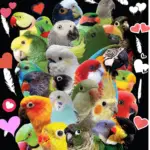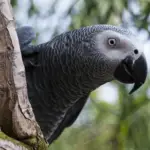
The Eclectus parrot is a bird native to the Solomon Islands, Sumba, New Guinea and nearby islands, northeastern Australia, and the Maluku Islands
It measures between 30 and 40 cm, weighs between 300 and 600 g, and its longevity is estimated at around forty years, although there are few studies on this subject.
This parrot is, in many respects, an exception among parrots.
First of all, and unlike many psittacines, the eclectus bird has a marked sexual dimorphism, so much so that for a long time we took the Eclectus male and the eclectus females for different species.
Eclectus male have bright green plumage, with red and blue feathers on the underside of the wings, flight feathers, and tail, with a coral orange beak on the upper mandible.
Eclectus Diet
The Eclectus parrot has a very different diet from other parrots. He is absolutely not a grain-eater, but rather a vegetarian. They need a daily food base made up of at least 80% fresh produce!
In other words, right from the start, feeding Eclectus is expensive, both in time and money. But they so deserve it!
Here are some fruits and vegetables that can make up his daily ration: apple, pear, cherry, melon, watermelon, papaya, mango, grapes, peach, apricot, banana, pomegranate, guava, tomato, strawberries, kiwi, beetroot, carrot, zucchini, broccoli, squash, red and green peppers, corn, peppers, beans. All this must be diversified and mixed in a varied way so that all the fruits and vegetables go through it!
And for the remaining 20%, they can consist of sprouted legumes, nectar and flowers, cereals (rice, couscous, wheat, oats), and a tiny bit of small seeds like millet and canary seed. . Mixes for canaries and nutriberries for parakeets often make them happy!

Eclectus parrots are very sensitive to vitamins of synthetic origin, which is why they should never be given vitamin supplements. Their digestive system does not assimilate them, and in the long term, the vitamins create toxicity for the liver and kidneys.
The only tolerated industrial origin additives are special Eclectus granules, and only those for this parrot, such as the Pretty Bird Specific Eclectus. But these must be given as a supplement and not as a staple food.
Eclectus drink little, most of their hydration being provided by fresh produce. If you feed him seeds and pellets, your bird will not absorb enough water to process solid food and synthetic vitamins, leading to liver engorgement and chemical toxicity.
We therefore seriously recommend applying to the diet of your Eclectus bird, because they are often very malnourished and are therefore victims of feather pecking.
Eclectus as pet
by their wild habits, are quite independent birds. They will appreciate human company if it is rich and stimulating. On the contrary, your parrot will take care of itself.
Eclectus parrots are quite economical with their energy, and Eclectus females can be prone to overweight from lack of physical activity. They must therefore be stimulated by introducing lots of foraging toys and educational activities rich in positive reinforcement.
Behaviourally, Eclectus male are not exclusive and accept all family members quite readily. Eclectus Females are more territorial, especially when it comes to their cages. Eclectus don’t share their cage! If you plan to have several birds, always plan a cage for each, the Eclectus bird is not lenders.
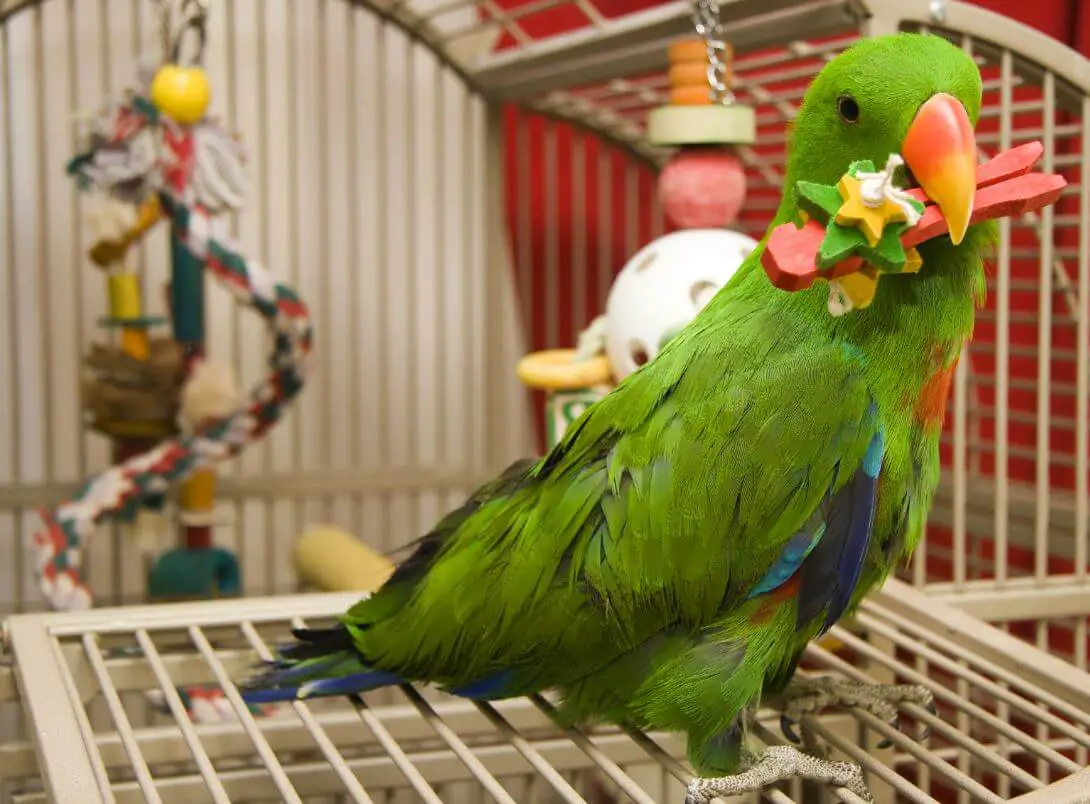
They are not destructive either. Their beak, made for biting into fruits and soft stems, is not as hard as other species. Eclectus will therefore love toys made of natural materials, softwood, and leather.
When it comes to speech, although Eclectus parrot can have hoarse squeals, they can also imitate the human voice and speak with a little girl’s voice. Both Eclectus male and females can learn, and their ability to speak will depend on the individuality of your bird, and also your ability to stimulate it.
Eclectus Breeding
In nature, a couple chooses a cavity in a tree trunk then the eclectus female lays 2 eggs there, and she will wait for the arrival of one or more eclectus males who will feed her during the brooding.
In captivity, breeding begins with displays consisting of feather preening and greeting. The female will then go to the nest, arrange it to her liking, and lay eggs.
Minimum breeding space per pair
Breeding in a cage is very difficult, these birds much preferring to breed in an aviary.
Bridge
2 to 3 white eggs, laid between May and September, depending on the subspecies.
Nest
Length 30 x width 30 x height 70 cm, vertical and preferably log rather than plank. Opening diameter 10 cm. Arrange a few shavings at the bottom to please the female.
Baggage
Diameter 11 mm at 14 days.
Incubation
26 to 28 days
Flight
12 weeks
Weaning
16 weeks
Eclectus parrot lifespan
This medium-sized, beautifully feathered parrot has 3 subspecies that are commonly kept as pets and can all live for over 20-30 years(In captivity up to 50 years). The male and female of these species are very different from each other.
Eclectus Male
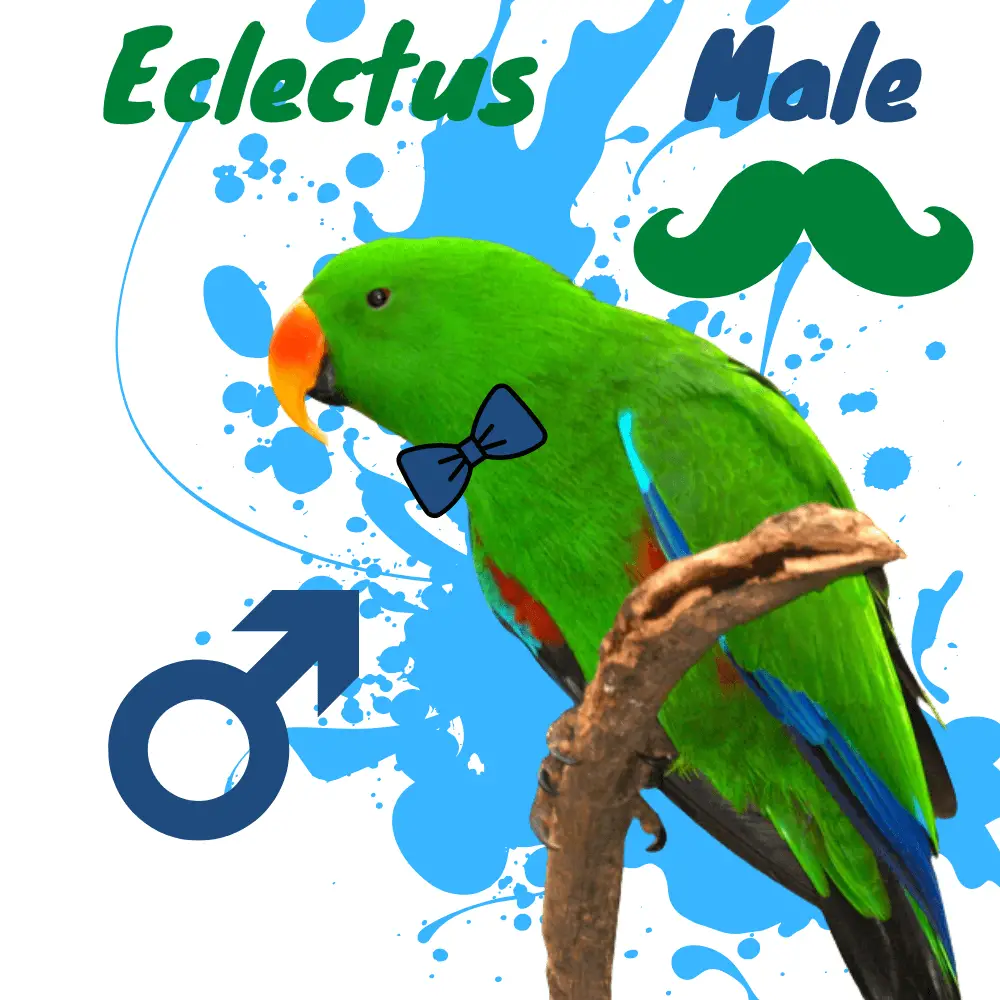
- There is one species of Eclectus bird: Eclectus roratus roratus and about ten subspecies. 30 to 35 cm long depending on the species. 300 grams for the smallest species up to 900 grams for the Australian Eclectus, the largest of all.
- Distribution: Indonesia, New Guinea, northeastern Australia, the Solomon Islands, and the Moluccas. Completely disappeared from Ambon, Saparua, and Haruku.
- In nature, it is found in lowlands of forests near clearings, in savannah, and in mangrove forests. It is arboreal. It is also unfortunately found more and more in cultivated areas, plantations and gardens.
- The Eclectus parrot is not a very gregarious animal. In the wild, it is most often found alone or flying with a single companion. It has occasionally been seen in small groups of parrots, but large groups of several birds are very rare.
- It is the dimorphic coloring that makes this bird so special and surprising. The Eclectus male has green plumage with some pale red under the wings. The upper mandible of the bill is orange and the bill is black. The female is predominantly red with a beautiful royal blue belly extending around the neck. The eye area is also blue in color. The bill is black.
- Another characteristic unique to this species is the texture of the feathers. It is closer to hairs than feathers. Because of this peculiarity, the Eclectus needs to keep its plumage always clean. Nothing is uglier than poorly maintained Eclectus plumage. Moreover, he himself does not tolerate that his plumage is soiled and can chew on his feathers or even try to remove them if they are oily or greasy.
- The beak of Eclectus parrot is more tender than that of other parrot species. This beak is not intended to open or chip hard nuts. Oftentimes, the Eclectus cannot even open an almond shell to extract the nut. The beak of the Eclectus is used primarily to cut the hard skin of fruits or the skin of green nuts. It is also used to tear the leaves and the bulbs of the flowers, to bite berries and small fruits, and finally, to remove the husks of the seeds.
- In captivity, poor nutrition is the main cause of Eclectus health problems. He needs a wide variety of soft foods on a daily basis ( not just once a week when there is time … ). It needs a large intake of fresh foods rich in beta-carotene: carrot, sweet potato, green leaves, etc. His diet should consist of 50 to 80% fresh fruits and vegetables.
- Fresh fruits: apple, pear, melon, papaya, grapes, banana, pomegranate, mango, guava, tomato, kiwi, etc.
- Fresh vegetables: beetroot, carrot, broccoli flower, zucchini, red and green peppers, corn, etc.
- In addition, it is important to provide: legumes, nectar, and flowers, cereals ( brown rice, couscous, barley ).
- Surprisingly, this large bird has a particular fondness for very small seeds such as millet, parakeet, or canary seeds.
- It is best to offer the larger seeds ( sunflower, safflower, etc. ) that have barely sprouted.
- Cheese, bones, spirulina, bread, and all table foods.
- There are now feeds formulated exclusively for Eclectus bird on the market. The latter does not in any way replace the foods listed above, it is a supplement to the diet.
- It is best to avoid giving vitamin supplements to the Eclectus unless directed otherwise by the veterinarian.
- This bird is not too reluctant to try new foods.
- It is important to provide a balanced diet, the female of the species has a tendency to be overweight.
Eclectus female
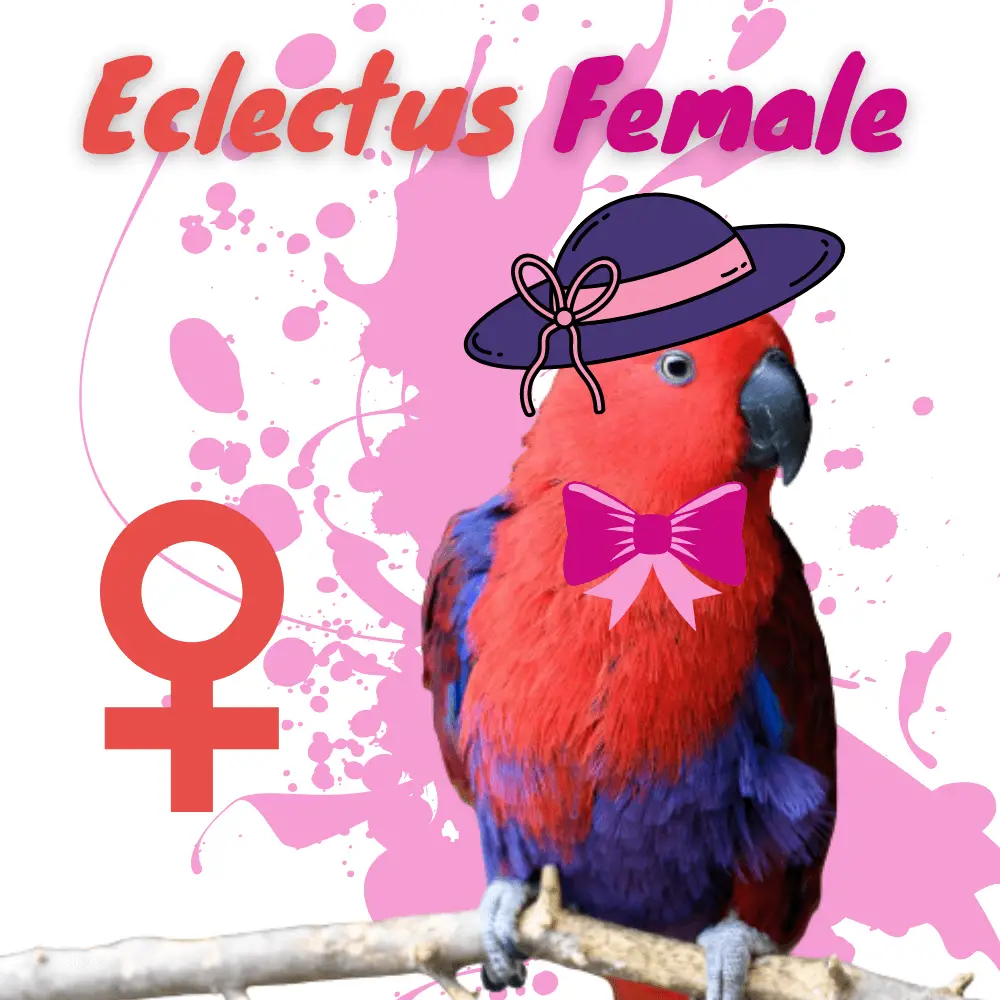
- The Eclectus parrot carries with it the reputation, mistaken, by the way, of being a bad pet bird. As it was mentioned above, the Eclectus is not a gregarious animal, so it is normal that it does not seek physical contact with humans, which is absolutely not to say that it does not like their company. Only, it does not enjoy being touched or petted as much as other species of parrots. Sometimes he can tolerate this kind of affection, but never very intimately or for too long.
- It is important to touch the Eclectus a lot when it is a baby to teach it that it is pleasant to be petted. It is not a natural behavior for him.
- It is also not natural for him to create very strong bonds with his partner ( human or bird ). It is up to the human being here to provoke the creation of these emotional bonds.
- It does not cohabit very well with other birds ( even those of its own species ) and absolutely does not tolerate intrusion into its territory ( cage ).
- The Eclectus male of the species has a milder temperament than that of the female. The latter is known to be moody and more territorial. In the eclectic world, it is the female who is the “boss”. Outside of the breeding season, the female can even be quite aggressive towards her Eclectus male.
- In general, we can say that the Eclectus is a calm, kind, reserved bird. He is not known to be a destructive bird in a house. On the other hand, he loves to nibble on softwood.
- It is not a loud bird, but like all parrots, “he has his hours!” He has a soft voice, is a good talker, and can reproduce the human voice well.
- The Eclectus is a self-sufficient bird that is often self-sufficient. He loves to swing alone and play quietly with his toys. It is therefore not energy-intensive from the point of view of the attention it requires.

